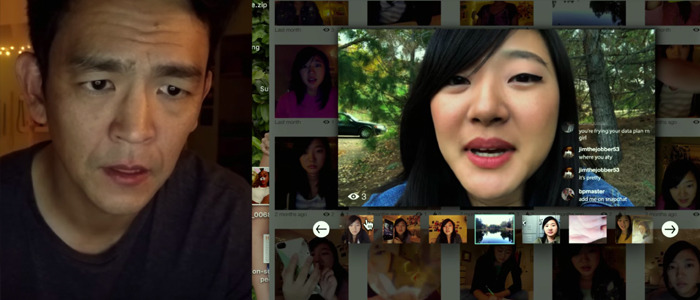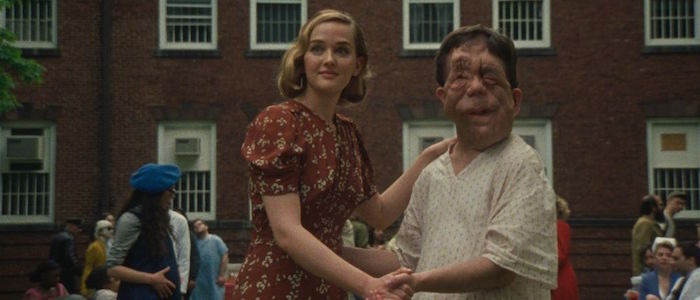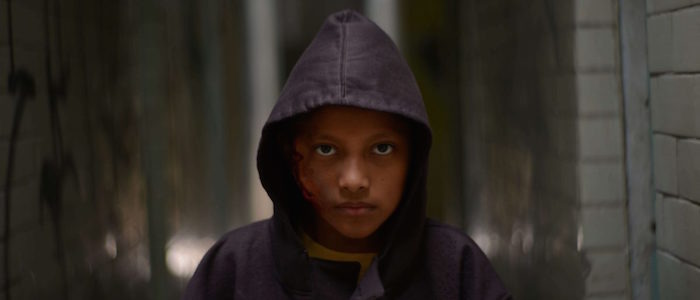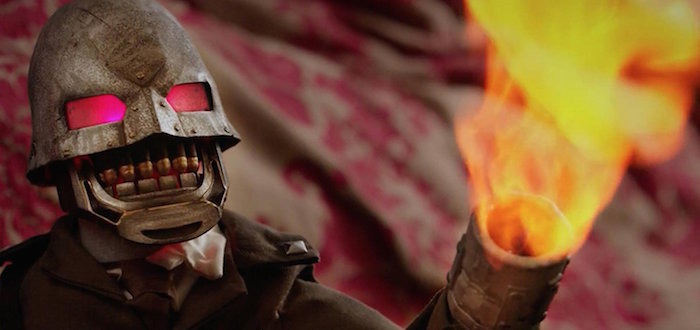What Is Genre Cinema Is 2018? Final Notes From The Fantasia Film Festival
From the first time you sit in that crowded theatre and hear the collective murmurings, you know that you're up for a special experience. Genre fans are some of the most passionate and knowledgeable film fans out there. And for these fans, Montreal's Fantasia Film Festival is like a pilgrimage. It's a chance to watch, discuss (and buy!) some of the best genre films of the year to come.But what's most peculiar about the festival is how it labels itself as a genre festival, but its programming often dissolves those established barriers. Genre is more a term used in film marketing departments than it is used by filmmakers. That's partly due to the fact that so many popular "genre" films nowadays are not just one thing. Indeed, Fantasia is home to the multi-hyphenate film: Japanese-Zombie-Meta-Comedy (One Cut of the Dead), High School-Christmas-Zombie-Musical (Anna and the Apocalypse), and Neo-Noir-Slacker-Comedy (Under the Silver Lake). Basically the one rule of mixing styles and genres is: if you can justify it, you can pull it off.Fantasia is taste tester for genre cinema. If you're a weird little movie, a badge of approval from the fest is as good as you can get. So, if the festival curates and shapes the future of genre cinema, maybe it can help answer a big question: what is genre cinema in 2018? Is it simply a re-working of classics from across genres? Though 2018 has showcased a lot of nostalgia horror, riding on the coattails of Stranger Things and It, there were only a few major nostalgia pieces (notably Summer of '84) at this year's festival. In fact, some of the most terrifying films were set in present day. One reason might be a budgeting one: period pieces are expensive and most genre films do not have big budgets.But another might also be that 2018's socio-political battleground is bloody terrifying.
Horror.com
"Screenlife" was a major subgenre at this festival. There were three features that took place entirely on computer screens and even more that engaged with online personas. If this subgenre says anything, it's that the internet is to fear. But the internet is only a vehicle, not the perpetrator. So then, the anonymity and physical distance that the internet provides is what's to fear. And of course, being targeted by people who know how to use the internet much, much better than you. That couldn't be more crystalline than in Unfriended: Dark Web, a thriller that positions the dark web as an unknowable force of evil that tortures regular folks just because they can. It's the first of perhaps many in the 'desktop invasion' subgenre. It hinges on whether you fear trolls spying on you through your laptop, rather than, say the NSA.Searching on the other hand offers a more nuanced perspective. An online assailant kidnaps a girl, but John Cho's dexterous navigation of his daughter's laptop and social media accounts is what could save her. It's not a 'pure' screenlife film because it doesn't stick to a single device and often displays information solely for us. It takes the common parental fear of discovering your child has a second life you didn't know about and twists it to a reassuring end. Though it rolls its eyes at the performativity of certain internet users, it offers a much more wholesome view of average teens on the internet.Another film that does not offer a clear resolution is CAM. It's a thrilling feminist piece that doesn't for a second shame its cam-girl protagonist Alice/Lola for doing sex work. It builds tension and narrative around the theft of Alice's online persona. After getting locked out of her account, she watches in horror as an identical-looking Lola breaks her self-imposed camming rules (one being no fake orgasms) and pushes the boundaries to breaking point. Though the film lacks a satisfying explanation as to why and how this identity theft occurred, which reinforces the perception of the internet as faceless and nefarious, it doesn't ultimately position Alice as a victim. She is in control of how she presents herself online and will not cease sex work out of fear.We'll be seeing more thrillers and horror films set online. Heck, I wouldn't be surprised if Hollywood does an Invasion of the Body Snatchers screenlife-edition!
Reevaluating or Recreating the Maladies of Genre Cinema
As we peruse the back catalog of cinema, there are more than a few classics that could do with some reevaluating. Of course, reevaluating does not mean de-valuing as many would suggest. It simply means learning from the past so as to make more informed work.Chained for Life does a masterful job of paying homage to Freaks and Elephant Man, while questioning their politics. It doesn't propose we banish those films to a clearance bin, but rather asks how these films shaped our culture and our attitude towards disfigured and disabled people. The film is similar in that way to The Love Witch (which played at the festival in 2016). Both take aesthetic and narrative devices from these nostalgia pieces and reframe them. While Chained for Life might not be right for someone who wants a straight up Z-movie without the behind-the-scenes intrigue, it's a great indication of how genre cinema can bridge the gap between offering a caring critique and blindly indulging in nostalgia.Under the Silver Lake however, seems to simultaneously critique and reproduce the male gaze that dominates a lot of noir and neo-noir thrillers. It's like Chinatown but without the incest and a slacker stoner instead of Jack Nicholson, right? Or like Mulholland Dr., but instead it's about a dude that's seen that movie too many times? Sorta, yeah. Because everything is seen through the paranoid, sex-craving perspective of a young man, it's unclear how critical David Robert Mitchell is of this perspective. Certainly, the climax of the film does offer some of kind of ironic feminist retribution, but there are too many two-dimensional women in the film for it to make its case as a new kind of neo-noir that doesn't keep women in the shadows. Beyond its lopsided representation, the film seeks meaning where there appears to be none. And then it beats you over the head with it.
Femme Horror
Whether or not you think that horror film is historically misogynist or feminist is a whole debate and one that I will not get into here. Masochistic viewing pleasure aside, women do want to see developed female characters on screen (whether they survive until the end or not). There's a movement in female-helmed horror films towards depicting "badass women." Basically, women that fight back. Hard. While I'm all for that, I do question whether that is being used as a sole character trait.For example, the short-form series La Quinciñera premiered at the Festival. It's about a Quinciñera that's violently interrupted by a cartel. Though the show does take some time to set up Alejandra's (Mia Xitlali) anxiety about the upcoming party, the show felt like little more than a series of entertaining stunts and kills performed by women. The numerous deaths of her family members had little to no emotional impact, which makes the pursuit for revenge feel numb. You can't tell a satisfying revenge story without setting the stakes. Perhaps the filmmakers' mistake is in their reliance that audiences will be fans of classic revenge flicks like Kill Bill as to ride some of their impact. But it's not enough to just portray women as badass because they can fight just as well (or better) as the men.Tigers Are Not Afraid is an excellent example of a horror film that draws from real-life horror and loss. Centered around a group of street kids trying to survive after their parents' murder in the ongoing drug war in Mexico, this is gritty magical realism tale told through the eyes of children, which makes it all the more tragic. The cartel violence does not feel like a cultural stereotype. It is a daily trauma, lived by everyone affected by it. Writer/director Issa López does not exploit the violence, nor does she brush it off. Although these two works are very different in style, influence and format, they are both about cartel violence in Mexico. Tigers Are Not Afraid deploys fairy tale tropes to combat real life horror. Lopez uses fantasy as a conduit for trauma and how we cope with it.
Regressive or Retro?
The two films at the festival that provoked the strongest reaction in me (and in my others) were Arizona and Puppet Master: The Littlest Reich. Arizona is a comedy/horror film set at the peak of the housing crisis. Danny McBride plays an emasculated husband with a failed business and a faulty mortgage and takes out his rage on anyone in shooting distance. The film does take pleasure in McBride's unlikely candidature as (successful) serial killer, but McBride's weaponized idiocy is more frightening than it is amusing. The film doesn't seem to know whether to laugh off scenes of brutality or show them as evidence in the case against him. Although the premise of a stupid serial killer (a dumb Dexter if you will) is amusing, his poor impulse control and unexpected bursts of anger will be all too familiar to many women as tell-tale signs of domestic abuse. McBride was hilarious as Kenny Powers in Eastbound and Down, but that persona doesn't transfer seamlessly to a serial killer. If you're going to make a horror film about an abusive husband, don't follow each blow to the head with a joke.Puppet Master: The Littlest Reich is the latest installment in the freshly rebooted Puppet Master series. Originally, the creator of the killer puppets at the center of the action, André Toulon, was a victim of the Nazi regime and used his puppets to help him take revenge. But the new film, produced by Cinestate, reverses the origin story and turns Toulon into a Nazi and puppets target marginalized people. And the film acknowledges this. But the grotesque (albeit impressive) acts the puppets commit are the equivalent of a cheeky "up yours" to progressives. The victims of the hate crimes do not come out conquerors. Ultimately, their story is told by a straight, white comic book artist (Thomas Lennon). It revels in the torture and killing of the marginalized under the guise of being (sort of?) critical. But it's not enough to just acknowledge that the violence is gendered or racialized to justify portraying it.I'm not advocating for the PC-afication of genre cinema. Genre cinema is not PC. Midnight movies are not mainstream crowd-pleasers. Genre cinema pushes the boundaries and tests our limits. It taps into what we as a society find most disturbing and frightening and turns it into fun and visceral experience. To give credit where credit is due, the practical effects of the murders are very well done and no doubt will be the drawing factor for many fans. Ultimately, it boils down to a question of whether or not shock cinema can survive in today's politically-conscious world, or just on Twitter. I envision the film being assigned in some film professor's seminar on "Trump's Cinema" in 30 odd years. But unlike exploitation cinema, this film is not provoking censorship laws or working through race relations for instance. Yes, it is exploring "woke" culture and but only by provoking it. And the fact that it condemns the kills but takes great pleasure in them makes me question whether it's trying to get away with it.To speak about genre cinema as a separate entity from mainstream cinema feels both inaccurate and misleading. Perhaps 'genre' cinema is a sliding scale of experimentation. Or an adjective. The more 'out there' you are in your choice of subject and style the more 'genre' you are. Or at least, the more likely people will be to label the film as such. One thing is for sure, genre cinema is provocative. It doesn't play it safe. And nor should it. After all, we don't watch scary movies to feel safe. But we need to pay attention to how these stories get told, and by whom. Whose agenda are they pushing and what harmful narratives are they perpetuating?




